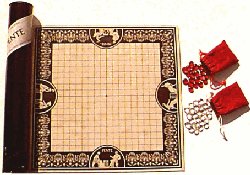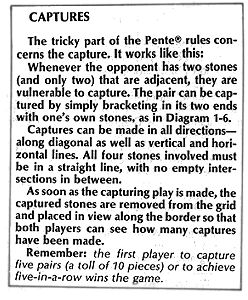
This commercial row game was purchased by the Museum in 1981. It was manufactured by Pente Games, Stillwater, Oklahoma (US), copyright 1977. Pente is a variation on traditional five-in-a row games such as Go-Moku and Go-Bang. The Pente Games Company was bought by Parker Brothers in 1984.
Reference: Tom, Braunlich, The Official Book of Pente, Chicago: Contemporary Books, Inc., 1983, ISBN 0-8092-5522-7.
The cylindrical container (left side of photograph) is 45.3cm high x 6.5cm diameter and is made of paper covered heavy cardboard. The top and bottom are plastic. The gameboard (illustrated in the photograph) is a 41.5cm vinyl square, divided into a matrix of square cells. The back is colored black. In the cylindrical container along with the board (which is rolled up for storage) are a set of instructions in English, and two fabric pouches (10.25cm long x 8.5cm wide) of "stones". The "stones" are markers used in the game. Each stone marker is about 2cm in diameter and appears to be made of glass. There are two sets: "red" and "clear" - one set for each player.
The name of the game is based on the Greek word for the number five. Markers are played on the intersecting lines of the board. The game begins by the player with the "clear" markers placing one marker on the center intersecting lines. Since there are no restrictions on which intersecting lines a marker can be placed, the second player places a "red" marker anywhere on the board. From then on, the players alternate moves, until one player places five markers in either a vertical, horizontal, or diagonal row. The player with "five-in-a-row" wins the game. However, there is a second method for a player to win the game, and that is by "capturing" 10 of the opponent's markers. "Capture" is accomplished in the following manner:


Last update March 30, 2010